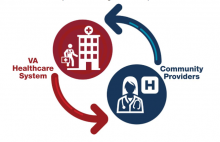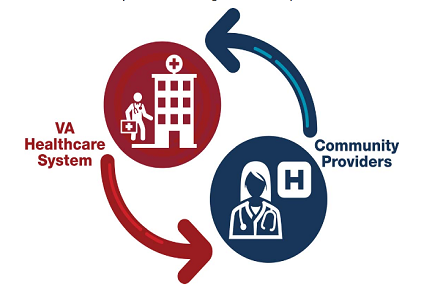User login
Secretary of the VA Robert McDonald and Deputy Secretary Sloan Gibson met with the members of the Commission on Care to defend the importance of the VHA and respond to criticism leveled in a recent report. In March, a report cosigned by nearly half the Commission members called for the closure of all VHA facilities and the transfer of patients to private care facilities.
“I know transformational change is not easy, but it is our commitment to the veterans we serve in order to bring them the customer service and the care and benefits they have earned,” McDonald told the Commission on Care.
“We have challenges in VA, and we own them,” Deputy Secretary Gibson added. “The transformation that [Secretary McDonald] talked about is well underway and already delivering measurable results for improving access to care and improving the veterans’ experience.”
Gibson laid out the VA plan to become a more integrated system going forward. By streamlining its supply chain, the VA had redirected $24 million back to veteran care. Real-time customer-satisfaction feedback is now being collected through VetLink, which indicates that about 90% of patients are either “completely satisfied” or “satisfied” with the timing of their appointments. Furthermore, in the most recent Access Stand Down, Gibson reported that VHA staff reviewed the records of more than 80,000 veterans, identified just over 3,300 patients waiting for more than 7 days for a level 1 clinic, and scheduled 80% immediately and 83% within 3 weeks.
Assistant Deputy Under Secretary for Community Care Baligh Yehia, MD, MPP, MSHP, also made a presentation to the Commission on Care on the progress VA has made in its attempt to partner with DoD, Indian Health Service, academic hospitals, and private-sector providers. According to Yehia, the VA has made 1.4 million Choice Care authorizations and the provider network has increased to about 289,000 providers. The VA has also streamlined the system, making it easier for veterans to use and simplified the medical records submission requirements for providers.
In an April 10th speech to the United Veterans Committee of Colorado, McDonald took on the Commission more directly. “Some still argue that VA can best serve veterans by shutting down VA health care altogether. They argue that closing VHA is the kind of ‘bold transformation’ veterans and their families need, want, and deserve,” he said. “I suspect that proposal serves some parties somewhere pretty well. But it doesn’t serve veterans well, and it doesn’t sit well with me. Simple words of the Cadet prayer resonate—‘choose the harder right’ over ‘the easier wrong.’”
“I know business. I know what transformational change means. I know it’s not easy,” McDonald said. “That kind of proposal isn’t transformational. It’s more along the lines of dereliction. President Reagan gave veterans ‘a seat at the table of our national affairs’ nearly 3 decades ago. So let’s keep veterans in control of how, when, and where they wish to be served.”
Mandated by the Veterans Access, Choice and Accountability Act, the 15-member Commission on Care is charged with providing recommendations for reforming veterans’ health care before July 1, 2016.
Secretary of the VA Robert McDonald and Deputy Secretary Sloan Gibson met with the members of the Commission on Care to defend the importance of the VHA and respond to criticism leveled in a recent report. In March, a report cosigned by nearly half the Commission members called for the closure of all VHA facilities and the transfer of patients to private care facilities.
“I know transformational change is not easy, but it is our commitment to the veterans we serve in order to bring them the customer service and the care and benefits they have earned,” McDonald told the Commission on Care.
“We have challenges in VA, and we own them,” Deputy Secretary Gibson added. “The transformation that [Secretary McDonald] talked about is well underway and already delivering measurable results for improving access to care and improving the veterans’ experience.”
Gibson laid out the VA plan to become a more integrated system going forward. By streamlining its supply chain, the VA had redirected $24 million back to veteran care. Real-time customer-satisfaction feedback is now being collected through VetLink, which indicates that about 90% of patients are either “completely satisfied” or “satisfied” with the timing of their appointments. Furthermore, in the most recent Access Stand Down, Gibson reported that VHA staff reviewed the records of more than 80,000 veterans, identified just over 3,300 patients waiting for more than 7 days for a level 1 clinic, and scheduled 80% immediately and 83% within 3 weeks.
Assistant Deputy Under Secretary for Community Care Baligh Yehia, MD, MPP, MSHP, also made a presentation to the Commission on Care on the progress VA has made in its attempt to partner with DoD, Indian Health Service, academic hospitals, and private-sector providers. According to Yehia, the VA has made 1.4 million Choice Care authorizations and the provider network has increased to about 289,000 providers. The VA has also streamlined the system, making it easier for veterans to use and simplified the medical records submission requirements for providers.
In an April 10th speech to the United Veterans Committee of Colorado, McDonald took on the Commission more directly. “Some still argue that VA can best serve veterans by shutting down VA health care altogether. They argue that closing VHA is the kind of ‘bold transformation’ veterans and their families need, want, and deserve,” he said. “I suspect that proposal serves some parties somewhere pretty well. But it doesn’t serve veterans well, and it doesn’t sit well with me. Simple words of the Cadet prayer resonate—‘choose the harder right’ over ‘the easier wrong.’”
“I know business. I know what transformational change means. I know it’s not easy,” McDonald said. “That kind of proposal isn’t transformational. It’s more along the lines of dereliction. President Reagan gave veterans ‘a seat at the table of our national affairs’ nearly 3 decades ago. So let’s keep veterans in control of how, when, and where they wish to be served.”
Mandated by the Veterans Access, Choice and Accountability Act, the 15-member Commission on Care is charged with providing recommendations for reforming veterans’ health care before July 1, 2016.
Secretary of the VA Robert McDonald and Deputy Secretary Sloan Gibson met with the members of the Commission on Care to defend the importance of the VHA and respond to criticism leveled in a recent report. In March, a report cosigned by nearly half the Commission members called for the closure of all VHA facilities and the transfer of patients to private care facilities.
“I know transformational change is not easy, but it is our commitment to the veterans we serve in order to bring them the customer service and the care and benefits they have earned,” McDonald told the Commission on Care.
“We have challenges in VA, and we own them,” Deputy Secretary Gibson added. “The transformation that [Secretary McDonald] talked about is well underway and already delivering measurable results for improving access to care and improving the veterans’ experience.”
Gibson laid out the VA plan to become a more integrated system going forward. By streamlining its supply chain, the VA had redirected $24 million back to veteran care. Real-time customer-satisfaction feedback is now being collected through VetLink, which indicates that about 90% of patients are either “completely satisfied” or “satisfied” with the timing of their appointments. Furthermore, in the most recent Access Stand Down, Gibson reported that VHA staff reviewed the records of more than 80,000 veterans, identified just over 3,300 patients waiting for more than 7 days for a level 1 clinic, and scheduled 80% immediately and 83% within 3 weeks.
Assistant Deputy Under Secretary for Community Care Baligh Yehia, MD, MPP, MSHP, also made a presentation to the Commission on Care on the progress VA has made in its attempt to partner with DoD, Indian Health Service, academic hospitals, and private-sector providers. According to Yehia, the VA has made 1.4 million Choice Care authorizations and the provider network has increased to about 289,000 providers. The VA has also streamlined the system, making it easier for veterans to use and simplified the medical records submission requirements for providers.
In an April 10th speech to the United Veterans Committee of Colorado, McDonald took on the Commission more directly. “Some still argue that VA can best serve veterans by shutting down VA health care altogether. They argue that closing VHA is the kind of ‘bold transformation’ veterans and their families need, want, and deserve,” he said. “I suspect that proposal serves some parties somewhere pretty well. But it doesn’t serve veterans well, and it doesn’t sit well with me. Simple words of the Cadet prayer resonate—‘choose the harder right’ over ‘the easier wrong.’”
“I know business. I know what transformational change means. I know it’s not easy,” McDonald said. “That kind of proposal isn’t transformational. It’s more along the lines of dereliction. President Reagan gave veterans ‘a seat at the table of our national affairs’ nearly 3 decades ago. So let’s keep veterans in control of how, when, and where they wish to be served.”
Mandated by the Veterans Access, Choice and Accountability Act, the 15-member Commission on Care is charged with providing recommendations for reforming veterans’ health care before July 1, 2016.

